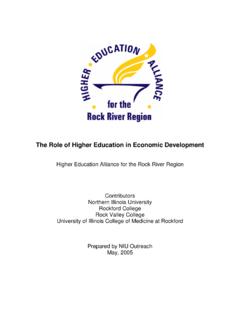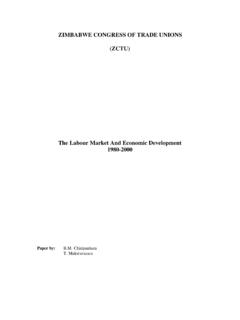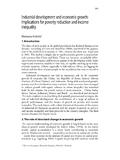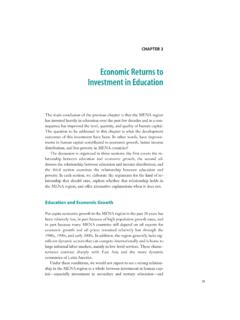Transcription of EDUCATION 5 INDICATORS INFOCUS - OECD.org - OECD
1 EDUCATION data EDUCATION evidence EDUCATION policy EDUCATION analysis EDUCATION statistics5IN2012/05 (May)1 EDUCATION INDICATORS in Focus 2012/05 (May) OECD 2012 EDUCATION INDICATORS FOCUSHow is the global talent pool changing?The global talent pool has grown rapidly over the past In 2000, there were 51 million 25-34 year-olds with higher EDUCATION (tertiary) degrees in OECD countries, and 39 million in non-OECD G20 countries. Over the past decade, however, this gap has nearly closed, in large part because of the remarkable expansion of higher EDUCATION in this latter group of countries. For example, in 2010 there were an estimated 66 million 25-34 year-olds with a tertiary degree in OECD countries, compared to 64 million in non-OECD G20 countries.
2 If this trend continues, the number of 25-34 year-olds from Argentina, Brazil, China, India, Indonesia, the Russian Federation, Saudi Arabia and South Africa with a higher EDUCATION degree will be almost 40% higher than the number from all OECD countries by the year 2020. The expansion of higher EDUCATION in rapidly-developing G20 nations has reduced the share of tertiary graduates from Europe, Japan and the United States in the global talent pool. If current trends continue, China and India will account for 40% of all young people with a tertiary EDUCATION in G20 and OECD countries by the year 2020, while the United States and European Union countries will account for just over a quarter. The strong demand for employees in knowledge economy fields suggests that the global labour market can continue to absorb the increased supply of highly-educated to read this chartThis chart shows upper, mid-range, and lower estimates of the number of 25-34 year-olds with higher EDUCATION in the coming decade for OECD countries, non-OECD G20 countries, and both sets of countries together.
3 The upper estimate assumes that in each country, the average annual growth rate of the number of 25-34 year-olds with higher EDUCATION between 2005 and 2009 will increase by 1 percentage point. The mid-range estimate assumes that the average annual growth rate over the last decade will remain constant. The lower estimate assumes that the proportion of 25-34 year-olds with tertiary EDUCATION will increase linearly in the coming decade (the progressively slower increase is because the size of the 25-34 year-old population is expected to level off in the future).250200150100500 MillionProjections of the number of 25-34 year-olds with tertiary EDUCATION , 2000-2020 Source: OECD Database, UNESCO and National Statistics websites for Argentina, China, India, Indonesia, Saudi Arabia and South and G20 countries non-OECD G20 countries OECD countries 2000 2001 2002 2003 2004 2005 2006 2007 2008 2009 2010 2011 2012 2013 2014 2015 2016 2017 2018 2019 2020 EDUCATION data EDUCATION evidence EDUCATION policy EDUCATION analysis EDUCATION statistics OECD 2012 EDUCATION INDICATORS in Focus 2012/05 (May) 2 EDUCATION INDICATORS IN the G20 nations with the fastest-developing economies have made the biggest gains.
4 The number of higher EDUCATION graduates will continue to grow in many countries through ahead, it s likely that the global talent pool will continue to grow across most OECD and G20 countries, and that the fast-growing G20 economies will continue to account for an increasingly large share. According to OECD calculations, there will be more than 200 million 25-34 year-olds with higher EDUCATION degrees across all OECD and G20 countries by the year 2020. What s more, 40% of them will be from China and India alone. By contrast, the United States and the European Union countries are expected to account for just over a quarter of young people with tertiary degrees in OECD and G20 countries. In fact, these projections may underestimate the future growth of the global talent pool, because a number of countries are pursuing initiatives to increase tertiary attainment rates even further.
5 For instance, in 2009 the United States established a goal to become the nation with the highest proportion of 25-34 year-old university graduates by 2020. To meet this target, officials estimate that the proportion of younger adults in the with a tertiary degree will need to reach 60% by the end of the decade. 91 million25-34 year-oldswith tertiaryeducation129 million25-34 year-oldswith tertiaryeducation20002010 United States, 17% China, 17% Russian Federation, 12% Japan, 10% India, 10% Korea, 4% Mexico, 3% France, 3% Germany, 3% United Kingdom, 3% Indonesia, 3% Spain, 3% Canada, 2% Brazil, 2% Turkey, 1% Other, 10% Share of 25-34 year-olds with a tertiary degree across OECD and G20 countries (2000, 2010) Note: Figures in these graphs are estimates based on available.
6 OECD Database, UNESCO and National Statistics websites for Argentina, China, India, Indonesia, Saudi Arabia and South States, 14% China, 18% Russian Federation,11% Japan, 7% India, 11% Korea, 4% Mexico, 3% France, 3% Germany, 2% United Kingdom, 3% Indonesia, 4% Spain, 2% Canada, 2% Brazil, 3% Turkey, 2% Other, 12% The rapid expansion of higher EDUCATION in fast-growing G20 economies has also caused a significant shift in the distribution of the global talent pool among countries. A decade ago, one in six 25-34 year-olds with a tertiary degree was from the United States, and a similar proportion was from China. Twelve percent came from the Russian Federation, and about 10% each were from Japan and India. By 2010, these same countries still possessed the largest shares of young people with a tertiary degree but in a very different order.
7 According to OECD estimates, China was at the head of the pack, accounting for 18% of 25-34 year-olds with a tertiary EDUCATION . The United States followed with 14%, the Russian Federation and India each had 11%, and Japan had 7%. EDUCATION data EDUCATION evidence EDUCATION policy EDUCATION analysis EDUCATION statistics3 EDUCATION INDICATORS IN focusEducation INDICATORS in Focus 2012/05 (May) OECD 2012 The continued growth of the knowledge economy will likely be important to absorb the growing talent addition, the European Union established a goal to increase the percentage of 30-34 year-olds who have completed tertiary EDUCATION by at least 40% in each EU country by 2020. In 2009, Belgium, France, Ireland, Luxembourg, the Netherlands, Sweden, Switzerland and the United Kingdom already reached this goal for the larger 25-34 year-old population.
8 Meanwhile, China which has quintupled its number of tertiary graduates and doubled its number of tertiary institutions in the last 10 years is also pursuing ambitious objectives. By 2020, China aims for 20% of its citizens or 195 million people to have higher EDUCATION degrees. If this goal is realised, China will have a population of tertiary graduates that is roughly equal in size to the entire projected population of 25-64 year-olds in the United States in many ways, the rapid expansion of the global talent pool and its expected growth in the future is no surprise. Since higher levels of EDUCATION are strongly linked to higher employment rates and larger earnings premiums, individuals have strong incentives to pursue more EDUCATION .
9 Similarly, as national economies continue to shift from mass production to knowledge economy occupations, countries have strong incentives to build the skills of their populations through higher EDUCATION . At the same time, the explosive growth of the talent pool raises an important question: Will the global labour market continue to absorb the increased supply of higher-educated workers in the future? Evidence from science and technology occupations jobs emblematic of the knowledge economy may provide some average across OECD countries, human resources in science and technology occupations (HRST) represented more than a quarter of total employment in 2010. In Luxembourg, Sweden, Denmark, and Switzerland, HRST workers accounted for more than 40% of all employees, while in India, China, and Indonesia, they accounted for less than 10%.
10 More importantly, between 1998 and 2008, employment in HRST occupations increased at a faster rate than total employment in all OECD and G20 countries with available data. The average annual growth rate was uniformly positive, ranging from in China to in Iceland. This consistently upward trend and even the comparatively smaller shares of HRST occupations in fast-growing economies like China signals that the demand for employees in this knowledge economy sector has not reached its of 25-34 year-olds with a tertiary degree across OECD and G20 countries (2020) Note: e projections presented in this chart do not take into account policy measures being pursued in some countries to increase higher EDUCATION .

















